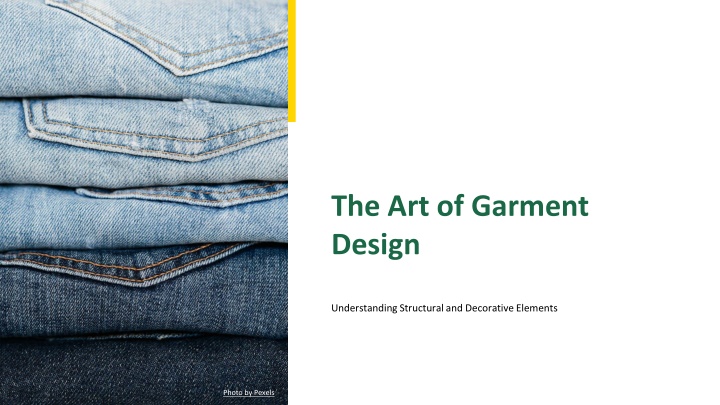
Exploring the Art of Garment Design: Structural and Decorative Elements
"Discover the essence of garment design through this comprehensive presentation, delving into the intricate balance of structural and decorative elements that define fashion. Learn about key design principles, requirements for good structural and decorative design, and the role of color and trends in creating visually appealing and comfortable garments."
Download Presentation

Please find below an Image/Link to download the presentation.
The content on the website is provided AS IS for your information and personal use only. It may not be sold, licensed, or shared on other websites without obtaining consent from the author. If you encounter any issues during the download, it is possible that the publisher has removed the file from their server.
You are allowed to download the files provided on this website for personal or commercial use, subject to the condition that they are used lawfully. All files are the property of their respective owners.
The content on the website is provided AS IS for your information and personal use only. It may not be sold, licensed, or shared on other websites without obtaining consent from the author.
E N D
Presentation Transcript
The Art of Garment Design Understanding Structural and Decorative Elements Photo by Pexels
01 Introduction to Garment Design Table of Contents 02 Understanding Structural Design 03 Key Elements of Structural Design 04 Requirements for Good Structural Design 05 The Role of Decorative Design 06 Requirements for Good Decorative Design 07 Classification of Design: Natural Motifs 08 The Impact of Color in Design 09 Design Trends and Innovations 10 Conclusion and Thank You!
1 Introduction to Garment Design The Essence of Style Garment design is a blend of artistic elements and principles that impact visual appeal and comfort. It takes into account the wearer's figure, aiming for aesthetics and favorable perception. Understanding design principles can enhance confidence throughflatteringdesigns. This presentation explores the layers of garment design from structure to decoration. Photo by Pexels
2 Understanding Structural Design Foundation of Fashion Structural design forms the backbone of any garment, intertwining construction and style seamlessly. It focuses on the essential components like lines, colors, and textures of the design. Good structural design corrects figure imperfections and enhances silhouette. Key elements include collars, sleeves, yokes, and seam lines that define shapes. Photo by Pexels
3 Key Elements of Structural Design The Building Blocks The core elements of structural design can be summarized into four categories: silhouette, lines, textures, and colors. Each element plays a vital role in defining the garment's overall aesthetics and function. A well-structured garment maintains proportional balance while offeringunity. Designs should be simple yet expressive, connecting with currentfashion trends. Photo by Pexels
4 Requirements for Good Structural Design Foundational Quality Effective structural designs should be uncomplicated and user-friendly. They must cater to the wearer's needs while being pleasing to the body structure. A harmonious blend of proportion and variation is essential for unity in design. Fashion evolves, yet simplicity remains a timeless quality in structural design. Photo by Pexels
5 The Role of Decorative Design Enhancing Beauty Decorative design enriches the basic structure, adding visual luxury and appeal. Trims and adornments create a more impressive garment reflecting personal style. It serves to elevate the inherent design without overwhelming it. The goal is to enhance, not distract, from the garment's structural integrity. Photo by Pexels
6 Requirements for Good Decorative Design Elegant Enhancements Moderation in decorative design ensures quality without overwhelming the structure. Strategic placement strengthens the garment's shape, enhancing overall appeal. Materials and services should align for maximum effectiveness in decorative choices. Allowing background space contributes to a sense of simplicity and dignity. Photo by Pexels
7 Classification of Design: Natural Motifs Nature-Inspired Patterns Natural designs draw inspiration from the environment, including flora and fauna. This category reflects scenic elements such as flowers, leaves, and landscapes. Using natural motifs can evoke emotions and connect wearers to nature. They serve as timeless inspirations for both structural and decorative designs. Photo by Pexels
8 The Impact of Color in Design Colors that Captivate Color is a powerful element of design, influencing emotions and perceptions. Choosing the right colors can elevate the garment's visual appeal and impact. It is essential to understand color theory to create harmonious designs. Different cultures may evoke varying emotions through color, making it critical. Photo by Pexels
9 Design Trends and Innovations Shaping the Future Staying current with design trends is essential for relevance in fashion. Innovations in materials and technologies shape the future of garment design. Sustainability is becoming an essential focus within the design industry. Designers must balance creativity with responsibility to meet modern demands. Photo by Pexels
10 Conclusion and Thank You! Appreciating Design's Journey Understanding garment design's structural and decorative elements is crucial to the craft. Each design decision impacts the wearer's experience and expression. Thank you for joining this exploration of the art and science of garment design. Let us continue to innovate and inspire in the world of fashion! Photo by Pexels
